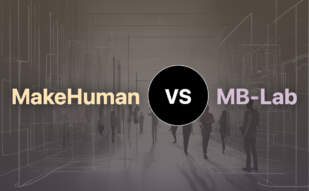MB-Lab is an open-source Blender plug-in known for photorealistic 3D human character modeling. Developed by Manuel Bastioni, it offers intuitive GUI and advanced tools for detailed modeling. Utilizing innovative technologies, it is compatible with Blender 2.79 and 2.80.
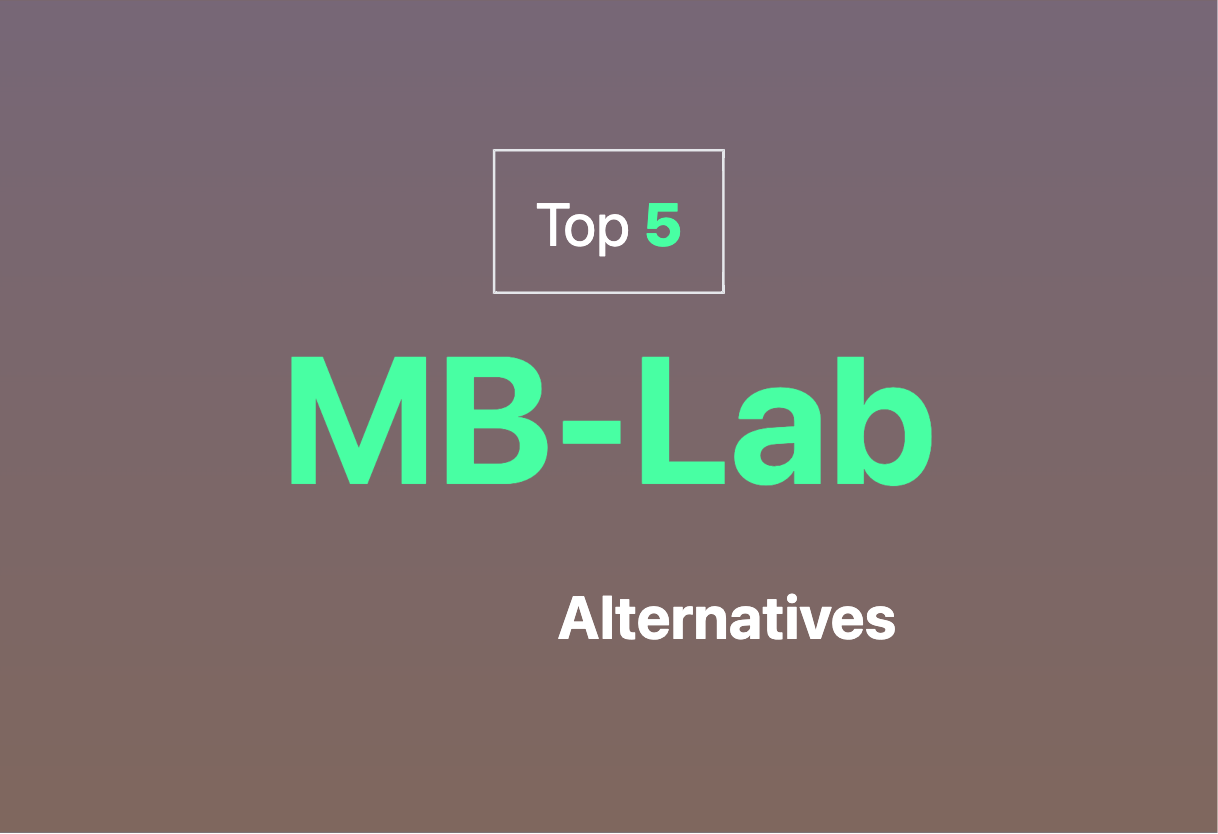
For those exploring alternatives to MB-Lab, options include Blender, MakeHuman, Daz 3D, Poser, and MetaHuman.
Blender
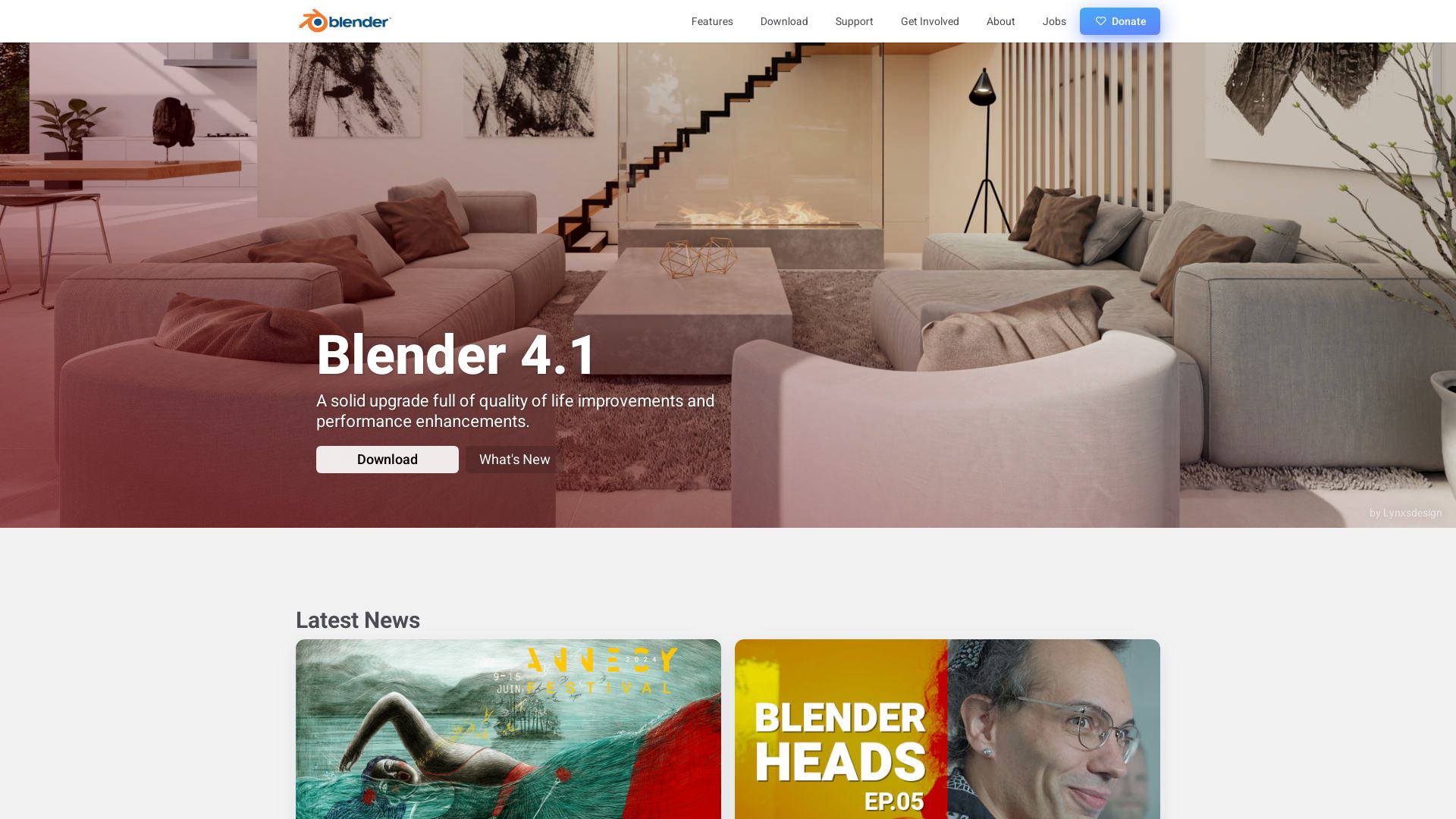
Blender is a 3D computer graphics software tool set developed by Dutch animation studio NeoGeo. It’s known for its wide utility in various domains from animated films to visual effects and virtual reality. It’s a free and open-source tool.
Blender Top Features
- Fully-featured 3D modelling and sculpting capability
- Extensive UV mapping and texturing functions
- Robust particle, fluid, smoke simulations
- Digital drawing and raster graphics editing alternatives
- Full animation, match moving, and rendering systems
| Support for Varied Languages | Written in C, C++, and Python, Blender caters to a wide range of developers. |
| Interoperability | Supports various 3D file formats like Alembic, 3DS, and FBX for easy import and export. |
| Availability | Compatible with a wide range of operating systems including Linux, macOS, Windows, BSD, and Haiku. |
Blender Downsides
- Blender’s Game Engine was deprecated in the 2.8 release.
- On their path to advancement, they removed Blender Internal in the 2.80 release, favoring the Eevee renderer instead.
Blender Pricing
Being free and open-source, Blender does not involve any costs. The platform is developed and maintained by the community and the Blender Institute.
Blender Use Cases
Use case 1: Animated Films
With its robust/support 3D modelling, animation, rendering and match moving capabilities, Blender serves as an ideal tool for creators in animated film-making.
Use case 2: Visual Effects
From motion graphics to particle and fluid simulations, Blender empowers visual effects artists to create cinematic-quality effects.
Use case 3: Virtual Reality
Blender’s broad range of interactive 3D application capabilities makes it fit for use in developing virtual reality experiences.
MakeHuman
Open your way to virtual humans with the rebellious solution of MakeHuman, an open-source tool that empowers you to craft a diverse range of virtual characters in a hassle-free way. Specialized in 3D modeling, it’s the perfect blending pot of human attributes opening doors to endless creative possibilities.
MakeHuman Top Features
- Interactive Graphical User Interface that simplifies the complexities of 3D modeling.
- Flexible manipulation of macro and detail attributes for creating realistic and unique 3D human characters.
- A library filled to the brim with resources like skin, eye color, cloth enabling rapid character creation.
- Supports Pose/Animate features to intricately design the bone structure.
- Parametric modeling to keep your creative freedom intact.
- Compatibility with top 3D software like Autodesk Maya, 3ds Max, Cinema4D via DAE, FBX, OBJ, STL export file formats.
- Pioneering GUI that delivers a smooth user-experience and quick access.
| Unique Features | Usage |
|---|---|
| Mesh Models | Ideal for subdivision surfaces modeling to achieve an optimized model. |
| 3D Morphing Technology | Keeps character transformation a breeze, be it for game development or academic research. |
| UV Models | Speeds up 3D Artist’s work by providing a unique UV for each model. |
MakeHuman Limitations
- Limited primarily to humanoid modeling, curtailing the scope for modeling non-human entities
- Updates are not very frequent, limiting the improvements and fixes to the tool
MakeHuman Pricing
Redefine the boundaries of your creations with Addession that starts at an affordable cost of $2 per month.
MakeHuman Use Cases
Use case 1 – Game Development
MakeHuman shines when it comes to game development. Its compatibility with popular game engines such as Unity and Unreal Engine makes it a desirable choice for game developers. Export your characters simply as collada or FBX files and integrate them into your gaming universe.
Use case 2 – Academic Research
MakeHuman is not just fun and games. Its application extends into serious academic research. Given its flexible features and realistic human morphing, it’s widely used in fields of biomedical engineering, virtual reality research, and visuo-haptic surgical training system development to name a few.
Use case 3 – 3D Character Modeling
For 3D artists and designers, MakeHuman is a boon. With its specialized topologies for advanced character modeling and unique UV for every model, it quickens the process, letting creators focus on the aesthetics and details of their design work.
Daz 3D
Emerging from the footprints of Utah in the millennium year of 2000, Daz 3D has evolved into the echelons of top-notch 3D-content and software companies. Known for its detailed and rigged 3D human models, it has carved its reputation amongst both hobbyists and the prosumer market. With an extended library of over 5 million assets for Daz Studio, the company’s relentless focus on 3D-content development and software offering redefines the scope of 3D graphics and modeling.
Daz 3D Top Features
- Genesis platform: Enables the creation of a diverse range of shapes through morphs with common base-add-on compatibility.
- Dual Quaternion compatibility: The Genesis 3 version is designed for seamless incorporation with other 3D software & game development platforms.
- Improved facial expressions: Genesis 8.1 version brings in enhanced depth and realism to eyes and mouth areas.
- Transfers to third-party apps: Daz Bridges tool ensures smooth transfers of content to applications like 3DS Max, Maya, Mudbox, Blender, etc.
- Cloth/hair simulation: dForce physics brings amazing realism in simulating natural cloth and hair.
| Feature | Benefit |
|---|---|
| Futuristic Technologies | Integration with innovative technologies such as NFT and content minting for the metaverse. |
| Bryce, Hexagon, and Carrara | Ownership of these unique packages contributes to Daz 3D’s capacities in landscape modeling, mesh modeling, and 3D modeling/animation. |
| Backward compatibility | Assets created in earlier Genesis versions can be used, ensuring the long-term utility of designs. |
Daz 3D Disadvantages
- For professionals and hobbyists, premium high-quality models can add to the cost.
- Genesis 8’s significant changes led to reduced backward compatibility.
- Interfaces with competitive software like Adobe Character Animator, MetaHuman Creator, and iClone that provide similar features.
Daz 3D Pricing
The product is free of charge and operates on a license-based pricing model in its marketplace.
Daz 3D Use Cases
Use case 1 – Film, TV, and Animation Industry
Daz 3D can be used to create ultra-realistic 3Dcharacters, thereby enhancing the visual experience.
Use case 2 – Video Game Development
With its ability to create a wide variety of 3D shapes and seamless compatibility with game development platforms, it is ideal for video game developers.
Use case 3 – Web Design and Print Illustrations
Bringing realism to web design and print graphics, Daz 3D can be employed profitably by graphic designers.
Poser
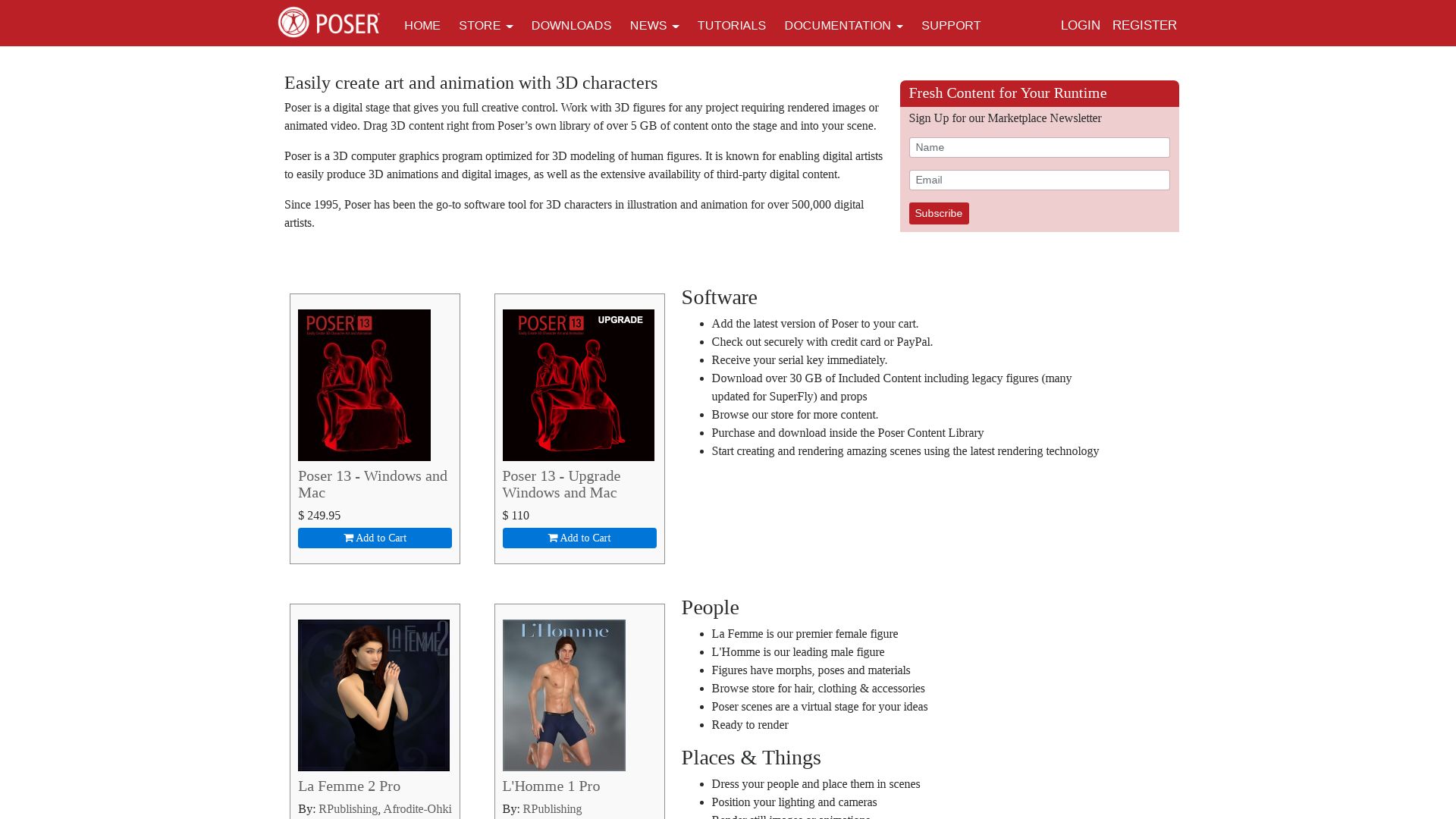
Poser is a top-tier 3D computer graphics program developed by Bondware, widely harnessed by digital artists to produce stunning 3D animations and digital images. It carries a specialized design to optimize 3D modeling of human figures, offering a comprehensive suite of features for seamless creation and modelling.
Poser Top Features
- Large library of pre-rigged figures: Poser has an extensive library comprising human, animal, robotic, and cartoon figures that are ready-to-use.
- Potent rendering tools: With powerful lighting and rendering capabilities, Poser assists in creating high-quality artistic effects, photorealistic styles, and more.
- Dynamic props and bullet physics: Poser comes equipped with dynamic assets and physics simulation to make your creations pop.
- Automatic keyframe creation: Poser makes animation easy through automatic keyframe creation, non-linear animation, and a built-in walk simulator.
- Rich preset catalog: Materials, facial expressions, poses, and more are provided in vast assortment, ready to be used in your projects.
| Custom Morphing Tools | Expanding creative possibilities with custom morphing tools. |
| User-friendly Interface | Full of interactive and intuitive features to aid users. |
| Expanded Graphic Card Support | Improved hardware compatibility to maintain high graphical performance. |
Poser Limitations
- Limited Languages: Poser is only available in English, French, German, and Japanese.
- Pricing: Poser is a premium service, starting at $249.95, which could be a barrier to some creators.
- Partial Professional Usage: Use in some professional fields noted but presence in others such as advertising or research fields is left unclear.
Poser Pricing
The pricing for Poser begins at $249.95 as a one-time payment. There is also a Pro version available with extra functionalities that is higher in cost. As a special offer, Poser 12 is currently available for a 75% discount.
Poser Use Cases
Use case 1
Digital artists can leverage Poser for the creation of high-quality 3D animations and digital images.
Use case 2
In the field of education, Poser’s pre-rigged figures and intuitive interface can enable teachers to illustrate concepts vividly.
Use case 3
With its powerful rendering capabilities and vast library, Poser is an excellent tool for professionals in the gaming industry for character design and animation.
MetaHuman
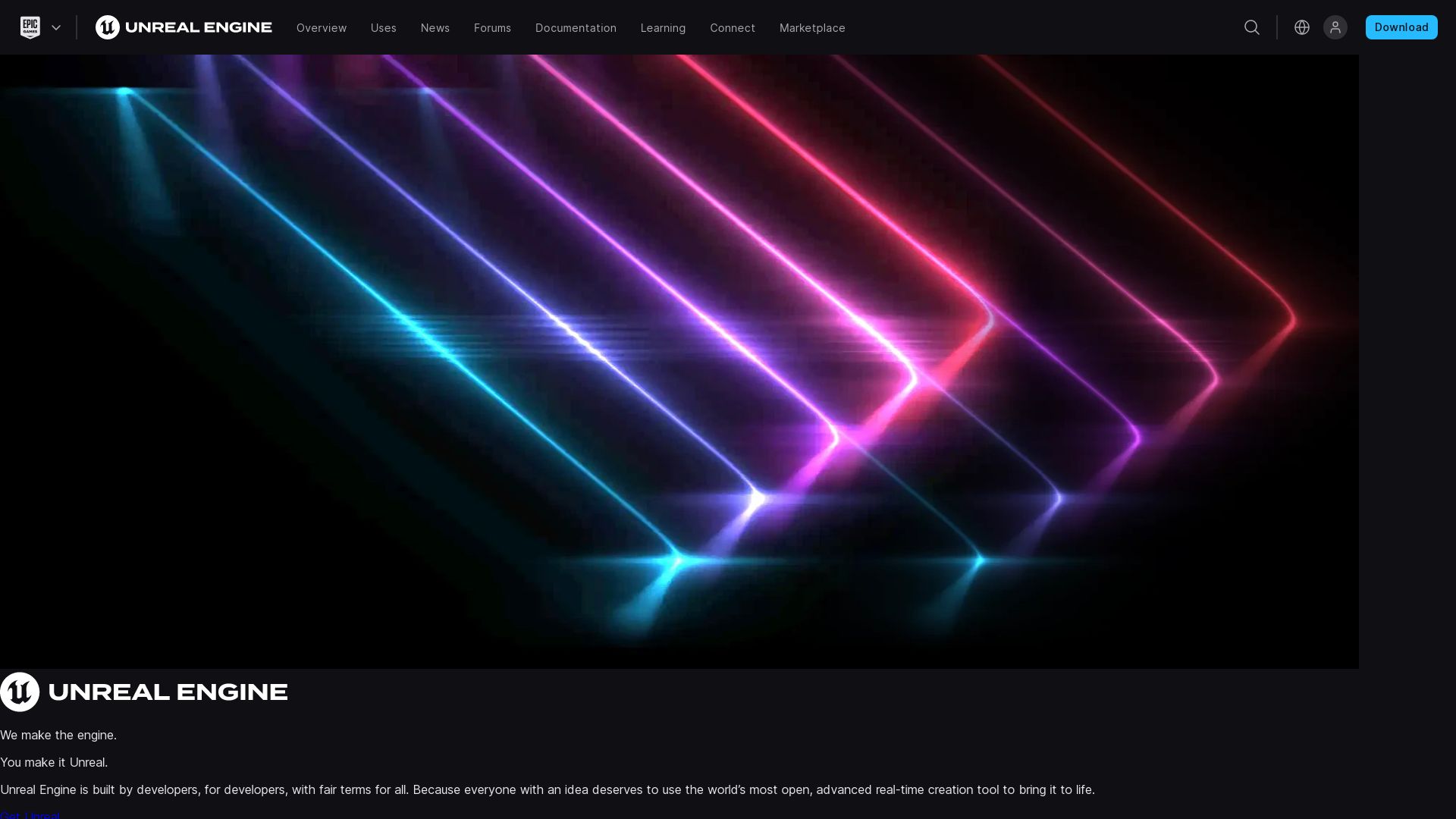
Envisioned atop the pyramid of metahumans, MetaHuman is synonymous with enhanced traits such as strength, speed, and superior senses, linked to the genetic variant known as the ‘metagene’. Initially associated with Vandal Savage, the first metahuman ancestor, it encapsulates a sweeping array of abilities including fire control, teleportation, and various physical transformations.
MetaHuman Top Features
- Flaunts a total of 1.3 million metahumans across the globe, showcasing a wide span of abilities and traits.
- Diverse categories identified by unique capabilities, enabling users to choose from an arsenal of powers.
- Universal powers such as telepathy, telekinesis, flight, energy projection, and accelerated healing readily available depending on the metahuman type.
- Exposure to physical trauma or chemistry, and even magic can trigger mutation activation, leading to physical alterations like wings, fur, or altered skin-color.
- Products include robust tools for role-playing games like D&D 5e Bag of Holding.
| Metahuman Trait | Activation method |
|---|---|
| Flight | Physical trauma or magic |
| Energy projection | Chemistry |
| Telepathy | Magic |
MetaHuman Downsides
- 99.5% of the metahumans are deemed “nuisance-level”, suggesting a low perceivable benefit for users.
- Choices like the exo-gene, developed by Lexcorp, have proven controversial due to creation of unstable heroes.
- Entities created carry significant risks like mind manipulation, soul consumption, and extreme physical transformation.
MetaHuman Use Cases
Use case 1: Role-Playing Games
For RPG enthusiasts, MetaHuman offers a kaleidoscope of choices. Its connection to D&D settings like Ravenloft, inspired by gothic horror, and tools like the D&D 5e Bag of Holding, adds an intricate layer of immersion and creativity to the gaming experience.
Use case 2: Continued Human Evolution
The unique metagene associated with enhanced traits in MetaHuman serves as a riveting prospect for deep-diving into human evolution and our genetic potential.
Use case 3: Psychological Exploration
MetaHuman’s horror campaign links offer a dark twist for exploring the human psyche and its ability to cope with psychological torment and fear.
Hannah Stewart
Content writer @ Aircada, tech enthusiast, metaverse explorer, and coffee addict. Weaving stories in digital realms.



